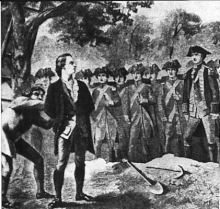Culper Ring
The Culper Ring was a network of spies active during the American Revolutionary War, organized by Major Benjamin Tallmadge and General George Washington in 1778 during the British occupation of New York City.The information supplied by the spy ring included details of a surprise attack on the newly arrived French forces under Lieutenant General Rochambeau at Newport, Rhode Island, before they had recovered from their arduous sea voyage, as well as a British plan to counterfeit American currency on the actual paper used for Continental dollars, which prompted the Continental Congress to retire the bills.The ring also informed Washington that Tryon's raid of July 1779 was intended to divide his forces and allow Lieutenant General Sir Henry Clinton to attack them piecemeal.Prior to British Major General William Howe's move from Staten Island, George Washington had received information of varying utility from individual spies working independently and without significant direction, such as Lawrence Mascoll.[1] After evacuating the Continental Army from Brooklyn Heights, Washington asked William Heath and George Clinton to set up "a channel of information" on Long Island, but he did not yet try to establish permanent agents behind enemy lines.Recently returned to service after being wounded before Brandywine, Clark set up a successful network, but poor health forced him to take up a desk job.[19] He provided a precise report on November 23 with the identity of British units and the numbers of troops and dispositions in New York City, which proved his worth as a spy.[23] Tallmadge set up couriers in December who would take messages the 55 miles (89 km) between New York and Setauket, initially Jonas Hawkins then mainly Austin Roe beginning in the early summer.[24] The courier's task was to get the letters to Brewster, who would pick up messages at one of six secluded coves near Setauket and take them across Long Island Sound with his rotating whaleboat crews to Tallmadge at Fairfield, Connecticut.[25][26][27][28][29] The historian Richard Welch writes that the tradition of the clothesline signal is unverifiable, but it is known that the British suspected a Setauket woman who fit Anna's profile of Patriot activities.In a January 1779 report received by Washington in early February, Brewster sent some information about naval matters and boat building at New York City and warned that Loyalists were outfitting privateers for operations on Long Island Sound.[31] That was delivered with a message from Woodhull that precisely described the British regiments and commanders at the northern tip of Manhattan, totaling about 8,500 men.[31] Tallmadge and Washington thought that the boats might be planned for transport for an attack against Connecticut from Major General William Tryon, who had conducted a raid during the winter.[35] In late June, Washington sent a letter to Tallmadge in which he identified George Higday as a possible operative to relieve Woodhull in New York City.On July 2, British cavalry under the command of Colonel Banastre Tarleton attacked Tallmadge's camp and captured his horse and some papers, including the letter mentioning Higday.[38][39] Once Townsend began his intelligence activities in New York City, Woodhull operated almost exclusively from Setauket and revised the communications network.[45] Among the techniques that the Culper Ring used to relay information were coded messages published in newspapers and invisible ink,[46] called a sympathetic stain, to write between the lines of what appeared to be typical letters.The letter also provides evidence that the Culper Ring operated in Drowned Meadow beyond Setauket and Oyster Bay, as previously believed.The letter is housed in the William L. Clements library at the University of Michigan, where it was discovered by Sternberg, a former resident of Port Jefferson researching the Culper Ring.Some of those informants or associates included Joseph Lawrence, a Long Island resident; Captain Nathan Woodhull, Abraham Woodhull's uncle, who served as a Loyalist militia officer but provided information to Abraham; Nathaniel Ruggles, a schoolmaster and physician born in 1713; Joshua Davis, a Brewster deputy and occasional substitute; and William T. Robinson, a merchant.[68] He was married to Elizabeth Sanders, daughter of a Royal Navy admiral, and he also had a fashionable clothing business near Robert Townsend's establishment.




Culper Ring (comics)Benjamin TallmadgeGeorge WashingtonSetauketNew York CityAbraham WoodhullRobert TownsendCaleb BrewsterAustin RoeAnna StrongAgent 355American Revolutionary Waroccupation of New York CityCulpeper County, VirginiaBritish ArmyLong IslandConnecticutBritish evacuation of New YorkRochambeauNewport, Rhode IslandContinental dollarsContinental CongressTryon's raidHenry ClintonBenedict ArnoldJohn AndréWest Point, New YorkHudson RiverNathan HaleWilliam HoweStaten IslandWilliam HeathGeorge ClintonWilliam DuerNathaniel SackettPhiladelphiaElias DaytonMersereau RingBattle of BrandywineJohn ClarkNorwalk, ConnecticutBattle of Rhode IslandCharles Scottsurveyorline of communicationNew York State Route 25AEast Setauket, New YorkJonas HawkinsprivateersWilliam TryonJohn Graves SimcoeQueen's RangersBanastre Tarletondouble agentJames Rivingtondead dropdragoonsRaynham HallOyster Bay, New Yorkinvisible inkMorton PennypackerAlbert S. OsbornNissequogueDrowned MeadowTBR News MediaSarah (Sally) TownsendHercules MulliganAlexander HamiltonSons of LibertyKing's CollegeStephen KnottWilliam LivingstonGroton, New YorkJames Fenimore CooperThe SpyBrian K. VaughanLucia St. Clair RobsonShadow PatriotsWhite CollarIdentity CrisisBrad MeltzerIntelligence in the American Revolutionary WarWhaleboat WarRaynham Hall MuseumMount Sinai, NYWayback MachineFerling, JohnLeckie, RobertRose, AlexanderLibrary of CongressPresident of the United StatesSenior Officer of the ArmyContinental ArmyDelegateSecond Continental CongressFirst Continental CongressMilitary careerRevolutionary WarFrench and Indian WarJumonville GlenBattle of Fort NecessityBattle of the MonongahelaForbes ExpeditionWashington in the American RevolutionCommander-in-chief, Continental ArmyAides-de-campWashington's headquartersoffice and sleeping tentBoston campaignSiege of BostonNew York and New Jersey campaignDelaware River crossingBattle of TrentonBattle of the Assunpink CreekBattle of PrincetonPhiladelphia campaignBattle of GermantownBattle of White MarshValley ForgeBattle of MonmouthBattles of SaratogaSullivan ExpeditionYorktown campaignSiege of YorktownNewburgh ConspiracyNewburgh letter